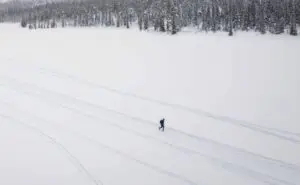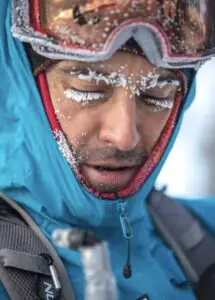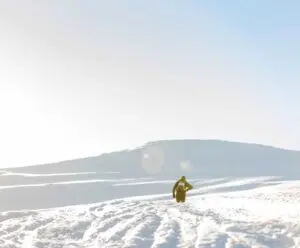A Like The Wind feature on the Ice Ultra. Words by Like the Wind, Brett Rocos and Damian Hall – Photography by Mikkel Beisner.
This is Swedish Lapland. Lying inside the Arctic Circle, it’s Europe’s last remaining wilderness and the heartland of the indigenous Sámi people. This region, Jokkmokk municipality, covers an area the size of Wales yet only has a population of around 3,000, and can experience daytime temperatures as low as -40°C during the short days of February.
Standing in snow, surrounded by seemingly endless pine forests scattered with frozen lakes, white-capped mountains dominate the horizon. All around is silent and peaceful, broken only by the crunch of runners’ footsteps as they make their way through 230km of this UNESCO World Heritage area. As darkness descends at the end of each day, it can feel as if you’re the only person on the planet.
This is the Ice Ultra.

The Ice Ultra’s stunningly yet amazingly tough conditions need more than a marshal on each corner and a cup of tea at the end. The terrain requires special care – it’s a long way from the nearest Accident & Emergency department.
Which is where Brett Rocos and his team come in. Rocos is the director of Exile Medics, the organisation that attends to the medical needs of the Ice Ultra competitors, as well as those of runners in extreme events in deserts and jungles. They plan and deliver the medical care from start to finish, as well as advising on environmental risks and health and safety. Before the race, they collect information on any pre-existing conditions the competitors might have and take equipment and personnel to suit (and there’s only one 30-litre kit bag per checkpoint).
“It’s absolutely spectacular in every way,” says Rocos of the Ice Ultra. But the scenery presents challenges. “No one knows how their system is going to react to being in the really cold until they’re in the really cold,” Rocos tells us. “The cold eats away at some people mentally, whereas others will physically feel it as soon as they get off the plane.” Temperatures also affect equipment: “A lot of the IV fluids you will normally use will just freeze,” Rocos says, “so we make plans to keep stuff warm or get things with a lower freezing point.” And the weather is far from predictable. “You can be getting sunburn on your face but frostbite on your toes.”

Every day, Rocos and his team hop on snowmobiles and assess the checkpoints (tepees with a fire inside) along that day’s route, which can be anything from 25km to 90km. “We deal with people as they come in,” he says. There’s also a roving rescue team, “the flying squad”, who can travel to a crisis on the course.
Rocos and the team work hard to educate the runners about the risks of the event and remembering to eat and drink enough, but hypothermia can come on dangerously quickly, as can frostbite or snow-blindness. Experience has taught the medics to adjust the drugs they carry: for example, they now bring Penthrox (an inhaled anaesthetic) instead of the less- temperature-stable morphine.
But even though Rocos briefs each competitor thoroughly, the conditions still come as a shock to some. As hypothermia takes hold, so does confusion, and this can be coupled with the desire to take off layers of clothing – not sensible. Rocos remembers one runner who hadn’t been eating properly and was found unconscious in the snow wearing shorts and a thin jacket. “For a good couple of hours, we thought he had died,” recalls Rocos. “We were lucky the helicopter could land and that the ice on the frozen lake was strong enough.”
Rocos is committed to continually improving the medical care on offer at extreme ultra events, but the competitors are also an attraction. “I like runners as a group of people,” he says. “They’re focused and determined and some of them have a personal drive that’s second to none.”

I’ve read more polar literature than is probably healthy,” admits Damian Hall, winner of the 2018 Ice Ultra, “but never been to Antarctica or the Arctic, so the Ice Ultra was a huge opportunity to see a really special part of the world, a once- in-a-lifetime trip.”
In fact, the geography was a huge reason Hall signed up for the race. “It was the travel experience that appealed more than anything,” he says, “then the sense of adventure, being out in the great white wilderness. Whether you need to run [in that terrain] is kind-of academic; it’s more about being able to just visit somewhere as special as this.”

Although, having said that, Hall didn’t tick all the “visit to the Arctic” boxes. “Obviously you want to get a bit cold, see the northern lights (I snoozed through my one opportunity to do this) and wrestle a polar bear, for the authentic experience,” he jokes.
The 2018 race was memorable for temperatures falling to the coldest levels they’ve hit throughout the event’s history. “There was a lot of snow, too,” remembers Hall, “the most for several decades, but that just made everything more beautiful.”
So how did the environment challenge the competitors? “We all took the necessary precautions,” recalls Hall, “but the conditions were just so, so cold. Liquid in my water bottles froze. My food froze. My eyelashes turned to ice.” Hall ended up running with a frozen energy bar sticking out of his mouth and his hands jammed under his armpits to keep them warm… which sounds like it must have been horrific, but not so for Hall. “It was plain wonderful,” he says. “I loved it.”
Hall’s main strategy to beat the hostile climate – and it paid off, taking him through the 230km in 27 hours and 45 minutes – was to run as fast as he could. Having suffered frostnip (the stage before frostbite) in the past – on his toes and what he calls “more intimate areas” – he wanted to mitigate against it happening again. He wanted to keep his body temperature high, and the added incentive of reaching the warmth of the cabin at the finish line propelled him through each stage.

The Ice Ultra doesn’t forge a path through uncharted territory; the indigenous Sámi population have lived among the snows of northern Europe for centuries. And while there weren’t any local contestants in the Ice Ultra, the Sámi and the race organisers got along well. “The Sámi were ace,” says Hall. “Super tough, but super friendly and very funny too. Great people. Lots of mutual respect.”
Briefly observing life in and around the race, Hall found a European familiarity in the urban areas, although admits that “Life looked tough… hard work.” And, as many tourists do when faced with a new language, he found humour. “Pleasingly,” he tells us, “they have a chocolate bar out there called Plopp.”






